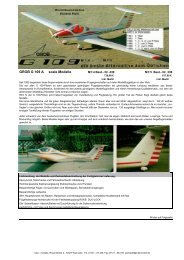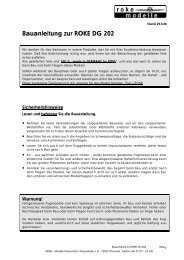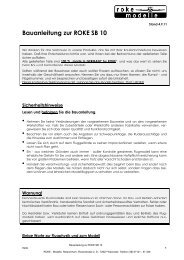Bedienungsanleitung Graupner JR mx-12 (englische Version) - ROKE
Bedienungsanleitung Graupner JR mx-12 (englische Version) - ROKE
Bedienungsanleitung Graupner JR mx-12 (englische Version) - ROKE
You also want an ePaper? Increase the reach of your titles
YUMPU automatically turns print PDFs into web optimized ePapers that Google loves.
Safety notes<br />
Disconnect all batteries and remove them from your model<br />
if you know you will not be using it in the near future.<br />
Capacity and operating times<br />
This rule applies to all forms of electrical power source:<br />
battery capacity is reduced every time you charge it.<br />
At low temperatures capacity is greatly reduced, i.e.<br />
operating times are shorter in cold conditions.<br />
Frequent charging, and / or the use of maintenance<br />
programs, tends to cause a gradual reduction in battery<br />
capacity. We recommend that you check the capacity of<br />
all your rechargeable batteries at least every six months,<br />
and replace them if their performance has fallen off<br />
significantly.<br />
Use only genuine GRAUPNER rechargeable batteries!<br />
Suppressing electric motors<br />
All conventional electric motors produce sparks between<br />
commutator and brushes to a greater or lesser extent<br />
depending on the motor type; the sparking generates<br />
serious interference to the radio control system. In<br />
electric-powered models every motor must therefore be<br />
effectively suppressed.<br />
Suppressor filters effectively eliminate such interference,<br />
and should always be fitted. Please read the notes and<br />
recommendations supplied by the motor manufacturer.<br />
Refer to the main GRAUPNER FS catalogue for more<br />
information on suppressor filters.<br />
Servo suppressor filter for extension leads<br />
Order No. 1040<br />
Servo suppressor filters are required if you are obliged<br />
to use long servo extension leads, as they eliminate the<br />
danger of de-tuning the receiver. The filter is connected<br />
directly to the receiver input.<br />
In very difficult cases a second filter can be used, positioned<br />
close to the servo.<br />
Using electronic speed controllers<br />
Electronic speed controllers must be chosen to suit the<br />
size of electric motor which they will control. There is<br />
always a danger of overloading and possibly damaging<br />
the speed controller, but you can avoid this by ensuring<br />
that the controller’s current-handling capacity is at least<br />
half the motor’s maximum stall current.<br />
Particular care is called for if you are using a „hot“ (i.e.<br />
upgrade) motor, as any low-turn motor (small number of<br />
turns on the winding) can draw many times its nominal<br />
current when stalled, and the high current will wreck the<br />
speed controller.<br />
Electrical ignition systems<br />
Ignition systems for internal combustion engines can<br />
also produce interference which has an adverse effect<br />
on the working of the radio control system.<br />
Electrical ignition systems should always be powered by<br />
a separate battery - not the receiver battery.<br />
Be sure to use effectively suppressed spark plugs and<br />
plug caps, and shielded ignition leads.<br />
Keep the receiving system an adequate distance away<br />
from the ignition system.<br />
Caution:<br />
Radio control systems may only be operated on the<br />
frequency bands and spot frequencies approved in each<br />
EU country. You will find information on frequencies in<br />
the section entitled „Approved operating frequencies“.<br />
It is prohibited to operate radio control systems on any<br />
other frequency, and such misuse will be punished by<br />
the relevant authorities.<br />
Static charges<br />
Lightning causes magnetic shock waves which can<br />
interfere with the operation of a radio control transmitter<br />
even if the thunderstorm actually occurs several<br />
kilometres away. For this reason cease flying operations<br />
immediately when you notice an electrical storm<br />
approaching.<br />
Static charges through the transmitter aerial can be<br />
life-threatening!<br />
Care and maintenance<br />
Don’t use cleaning agents, petrol, water or other<br />
solvents to clean this equipment. If the case, the aerial<br />
etc. gets dirty, simply wipe the surfaces clean with a soft<br />
dry cloth.<br />
Liability exclusion / Compensation<br />
As manufacturers, we at GRAUPNER are not in a position<br />
to influence the way you install, operate and maintain<br />
the radio control system components. For this reason<br />
we are obliged to refute all liability for loss, damage<br />
or costs which are incurred due to the incompetent or<br />
incorrect use and operation of our products, or which<br />
are connected with such operation in any way.<br />
Unless otherwise prescribed by law, the obligation of the<br />
GRAUPNER company to pay compensation is limited<br />
to the invoice value of that quantity of GRAUPNER<br />
products which was immediately and directly involved in<br />
the event in which the damage occurred. This does not<br />
apply if GRAUPNER is found to be subject to unlimited<br />
liability according to binding legal regulation on account<br />
of deliberate or gross negligence.<br />
Safety notes 5








